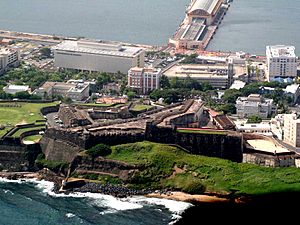Castillo San Cristóbal (San Juan) facts for kids
Quick facts for kids Castillo San Cristóbal |
|
|---|---|

Aerial view of Castillo San Cristobal
|
|
| Location | San Juan, Puerto Rico |
| Built | 1783 |
| Governing body | National Park Service |
| Official name: Castillo San Cristóbal | |
| Type | Cultural |
| Criteria | vi |
| Designated | 1983 (7th session) |
| Part of | La Fortaleza and San Juan National Historic Site in Puerto Rico |
| Reference no. | 266 |
| Region | North America and West Indies |
| Official name: Castillo San Cristóbal | |
| Designated | October 15, 1966 |
| Part of | San Juan National Historic Site |
| Reference no. | 66000930 |
| Lua error in Module:Location_map at line 420: attempt to index field 'wikibase' (a nil value). | |
Castillo San Cristóbal is a huge old fort in San Juan, Puerto Rico. The Spanish built it to protect the city from attacks coming from the land. It is now part of the San Juan National Historic Site.
This fort is the biggest one ever built by the Spanish in the New World (the Americas). It was finished in 1783. At that time, it covered about 27 acres of land. It also partly surrounded the city of San Juan. The fort's double gates controlled who could enter the city.
After almost 100 years of peace, part of the fort was taken down in 1897. This was done to make it easier for people and traffic to move in and out of the walled city.
Castillo San Cristóbal was built on a hill. This hill was first called Cerro de la Horca. Its name was changed to Cerro de San Cristóbal to celebrate Spanish victories. The fort also has five very large water tanks called cisterns. These were used to store water during the time of the Spanish Colony. They are 24 feet tall, 17 feet wide, and 57 feet long! During World War II, these big cisterns were even used as bomb shelters.
Key Moments in History

- 1521: The city of San Juan was started by Spanish settlers.
- 1539: The first defenses were built at Castillo San Felipe del Morro and La Fortaleza. They had cannons aimed at the harbor entrance.
- 1595: The English attacked San Juan. Sir Francis Drake led 25 ships past the cannons of El Morro. The English left without treasure.
- 1625: The Dutch attacked and took San Juan from the land side. This led to the building of defenses on San Cristóbal Hill. These defenses were meant to stop future land attacks.
- 1634: A small, three-sided fort was built on San Cristóbal Hill. This was on the northeast side of San Juan.
- 1766–1783: This was the main time of building for San Cristóbal. Royal Engineers Tomás O’Daly and Juan Francisco Mestre led the work.
- 1787: An earthquake damaged both San Felipe del Morro and San Cristóbal.
- 1797: San Cristóbal helped stop a British attack on San Juan. A large British force led by Sir Ralph Abercromby tried to invade. They were stopped about a mile from San Cristóbal.
- 1824: María de las Mercedes Barbudo, a woman who wanted Puerto Rico to be independent, was held captive here. She worked with Simon Bolivar to try and free Puerto Rico from Spanish rule. She was later sent away to Cuba.
- 1855: Soldiers at San Cristóbal rebelled against the Spanish rulers. They held the fort for 24 hours. They even turned the cannons towards the city, causing a lot of worry!
- 1897: A big part of the old walls from San Cristóbal to the harbor was blown up. This allowed San Juan to grow and expand.
- 1898: On May 10, the first shot of the Spanish–American War in Puerto Rico was fired. Captain Ángel Rivero Méndez ordered it from Castillo San Cristóbal. It was fired at the USS Yale. The fort's cannons fought with US Navy ships all day. Six months later, Puerto Rico became a US territory. This happened because of the Treaty of Paris, which ended the war.
- 1942: During World War II, the fort was still an active military base. Concrete bunkers and an underground control center were added. The old cisterns were prepared as fallout shelters.
- 1949: The San Juan National Historic Site was created.
- 1961: The US Army left the forts of Old San Juan. The United States National Park Service took over. They now preserve the forts as museums.
- 1983: The San Juan National Historic Site was named a World Heritage Site by the United Nations. This means it is a very important place for everyone in the world.
The Devil's Sentry Box
Most of San Juan's old walls have small guard towers called guerites (or garitas in Spanish). One of these at Castillo San Cristóbal is famous. It is called "The Devil's Sentry Box" (La Garita del Diablo). This guard tower gives watchmen a great view of the seashore. It also protects them. This particular sentry box is one of the oldest parts of the fort. It was built in 1634.
There are many old stories about soldiers disappearing from inside this sentry box. However, most people believe that only one soldier truly disappeared. His name was Sánchez. He supposedly ran away from his post to be with his girlfriend, Dina.
See also
 In Spanish: Castillo San Cristóbal para niños
In Spanish: Castillo San Cristóbal para niños
- Fuerte de San José
Images for kids
-
Cpt. Rivero Mendez






